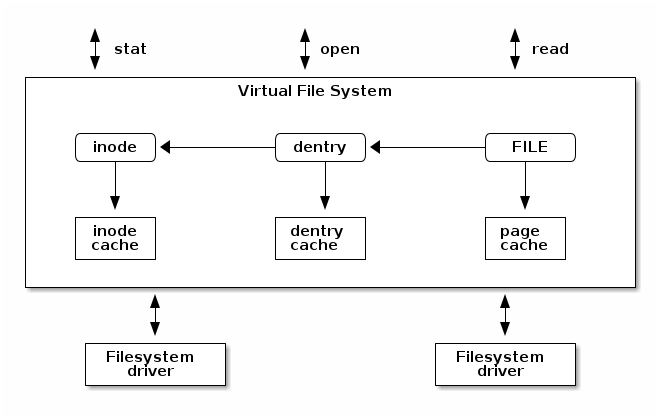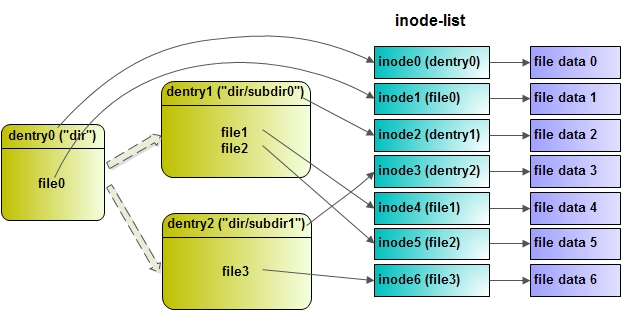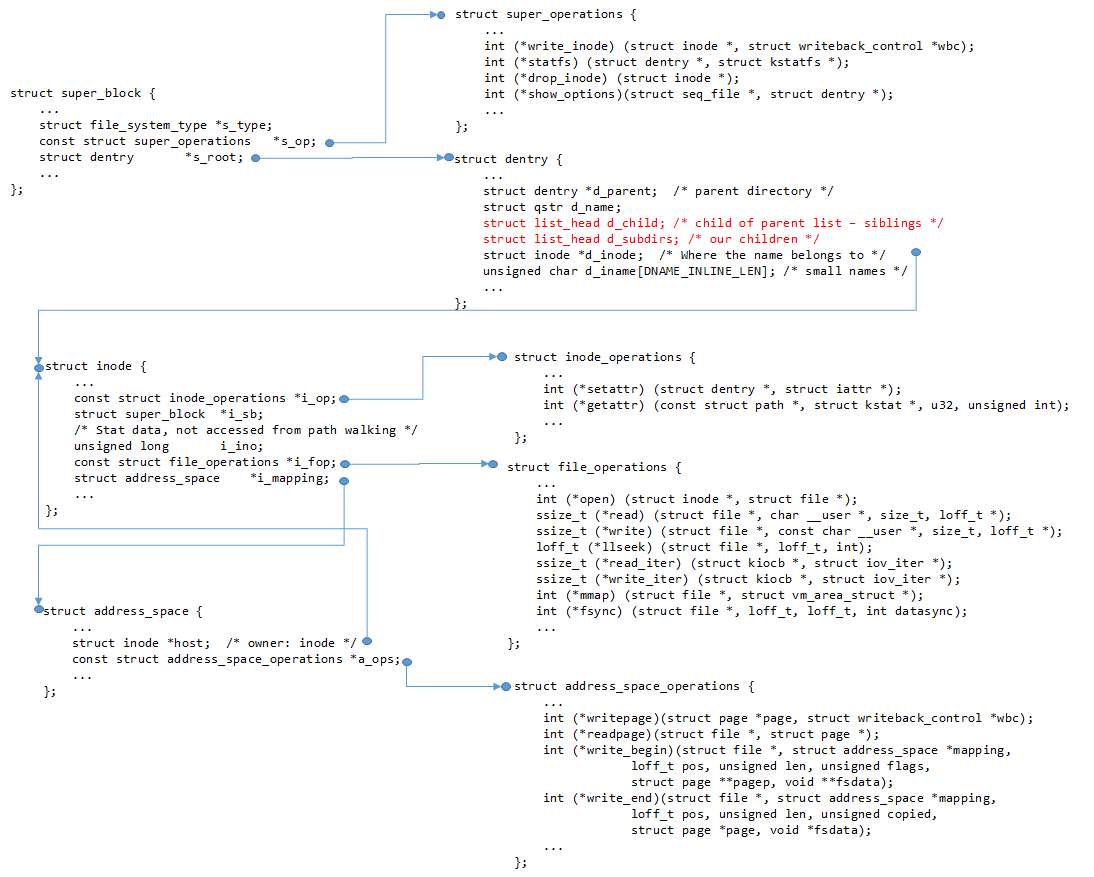building an in-memory filesystem driver from scratch
A file system is what allows us to organize files and directories into hierarchical trees. But how is this actually implemented in Linux?
Following the Feynman’s famous quote, we are going to build own in-memory file system driver to understand it. This guide focuses on the practical aspects necessary to get such a filesystem up and running. For a deeper dive, check out the references and the “Further Reading” section at the end.
You can find the source code in this repo.
How Do Users Interact with Filesystems?
Your first thought can be: “Through applications, the shell, or tools like ls and vim.” That’s true but let’s go one level deeper, and you’ll find system calls.
Whenever a userspace program performs an I/O operation: opening a file, reading data, or writing to disk - it issues a system call such as open, read, or write. These syscalls are the entry points into the kernel.
But how does the kernel handle them? How does it know where in memory to write the data, how to create or delete files, or which filesystem should respond?
We’re not going to cover syscall mechanics in this post (you can find excellent explanations here), but we’ll explore what happens after a syscall hits the kernel — specifically how the Virtual Filesystem (VFS) bridges this gap.
The Virtual Filesystem (VFS)
The Virtual Filesystem is a component of the kernel that handles all system calls related to files and file systems. Think of it as a universal adapter which allows multiple filesystems (ext4, tmpfs, NFS, your custom driver) to coexist and plug into the same syscall interface. VFS takes care of most of the complex and error-prone parts, like caching, buffer management, and pathname resolution but delegates the actual storage and retrieval to your specific filesystem driver.

How Does the VFS Interface Look?
Let’s work from first principles. If you were designing a filesystem interface, you’d want to define:
- Metadata about the filesystem itself: its name, block size, max filename length, etc.
- Operations on the filesystem: how to mount it, unmount it, query statistics, etc.
That’s exactly what Linux does using a structure called file_system_type.
file_system_type: Registering a Filesystem
This structure represents a specific type of filesystem (e.g. ext4, tmpfs, or myramfs) and provides the logic for mounting and unmounting it:
struct file_system_type {
const char *name;
struct dentry *(*mount)(struct file_system_type *, int, const char *, void *);
void (*kill_sb)(struct super_block *);
struct module *owner;
// ...
};
When your driver is loaded, you register this structure with the kernel using register_filesystem.
Superblock: Mounting a Filesystem
Once a filesystem is registered, how does it get used? The answer is: via mounting.
Every mounted instance of a filesystem is represented by a super_block structure, which tracks its root directory, all its inodes, and any internal metadata:
struct super_block {
struct list_head s_inodes; // All inodes in this mount
struct dentry *s_root; // Root directory entry
struct file_system_type *s_type; // Back-pointer to FS driver
unsigned long s_blocksize;
unsigned long s_magic;
const struct super_operations *s_op;
void *s_fs_info; // FS-specific data
// ...
};
The superblock esentially answers: “What does this filesystem look like once mounted?”
Inode: Representing Files and Directories
Next, we need a way to represent individual files or directories. In Linux, they’re both handled using a structure called an inode.
An inode holds metadata like size, permissions, timestamps, and pointers to file content. But importantly — it doesn’t store the filename.
Why not? Because the same inode can have multiple names (hard links), and we don’t want to duplicate the actual file or its metadata. The filename is managed separately, using a dentry.
Linux kernel implementation of inode is here.
Dentry: Directory Entry
A dentry (directory entry) maps a filename to its corresponding inode. You can think of it as the glue between filenames and the actual file content.

Multiple dentries can point to the same inode (e.g., via ln file linkname), enabling hard links without data duplication. You can inspect inode numbers with ls -i:
$ touch file
$ ln file link
$ ls -i
Example output:
49020997 file
49020997 link
Here’s a how dentry looks like in Linux kernel source code:
struct dentry {
//...
struct inode *d_inode; /* associated inode */
//...
struct dentry *d_parent; /* dentry object of parent */
struct qstr d_name; /* dentry name */
//...
struct dentry_operations *d_op; /* dentry operations table */
struct super_block *d_sb; /* superblock of file */
void *d_fsdata; /* filesystem-specific data */
//...
};
struct file: Open File Instances
When a file is opened (via open() syscall), the kernel creates a struct file instance. It tracks:
- The current offset (
f_pos) - Flags like read/write mode
- A pointer to the file’s operations (read, write, seek, etc.)
- A pointer to the inode and private data
This is what gets passed to your read, write, and ioctl handlers.
How it all interacts together?
Here’s how everything connects:

Implementation: define file system and its superblock
Now we can start implementing our filesystem driver. We’ll begin from scratch by defining the file system type:
static const struct super_operations rf_sops = {
.statfs = simple_statfs, // default function from lib
.drop_inode = generic_delete_inode, // default function from lib
.evict_inode = rf_evict // custom function; see implementation in the source
};
static int rf_fill_super(struct super_block *sb, void *data, int silent)
{
sb->s_op = &rf_sops;
sb->s_magic = RAMFSC_MAGIC;
sb->s_time_gran = 1;
// initialize root directory
struct inode *root;
root = rf_make_inode(sb, S_IFDIR | 0755); // custom function
if (!root)
return -ENOMEM;
root->i_op = &rf_dir_iops;
sb->s_root = d_make_root(root);
if (!sb->s_root)
return -ENOMEM;
return 0;
}
static struct dentry *rf_mount(struct file_system_type *t,
int flags, const char *dev, void *data)
{
return mount_nodev(t, flags, data, rf_fill_super);
}
static struct file_system_type rf_fs_type = {
.owner = THIS_MODULE,
.name = "myramfs",
.mount = rf_mount,
.kill_sb = kill_litter_super,
};
static int __init rf_init(void) { return register_filesystem(&rf_fs_type); }
static void __exit rf_exit(void) { unregister_filesystem(&rf_fs_type); }
The VFS provides two functions for registering and unregistering a filesystem: register_filesystem and unregister_filesystem. Both accept a file_system_type structure, which defines the owner, the name of the driver (remember this—we’ll use it when mounting later!), and two function pointers invoked during mount and unmount operations, respectively.
Let’s examine those functions more closely. rf_mount is called during the mounting process. It simply delegates to the standard mount_nodev, which initializes the superblock and then calls rf_fill_super to finish the setup.
rf_fill_super performs two main tasks: it completes the superblock initialization and attaches the root directory to it.
How to operate under root?
root is a directory, so we need to define how to look up files, create new files, and create subdirectories under it. All of this is specified in rf_dir_iops (remember how we assigned it when creating the root inode?). Let’s take a closer look:
static const struct inode_operations rf_dir_iops = {
.lookup = simple_lookup,
.create = rf_create,
.setattr = rf_setattr,
.mkdir = rf_mkdir,
};
For now, we define just four operations:
-
lookup: a default VFS function used to resolve names to dentries. -
create: used to create regular files. -
setattr: used internally by the VFS to set inode attributes. -
mkdir: used to create directories.
Let’s walk through each of these:
static int rf_create(struct mnt_idmap *idmap, struct inode *dir,
struct dentry *dentry, umode_t mode, bool excl) {
struct inode *ino = rf_make_inode(dir->i_sb, S_IFREG | mode);
struct rbuf *rb;
if (!ino)
return -ENOMEM;
rb = kzalloc(sizeof(*rb), GFP_KERNEL);
if (!rb || rf_reserve(rb, PAGE_SIZE)) {
iput(ino);
kfree(rb);
return -ENOMEM;
}
ino->i_private = rb;
d_add(dentry, ino); // bind dentry to inode
return 0;
}
When creating a new file, the VFS calls rf_create. The steps are:
- Allocate an inode — the core structure holding file metadata.
- Since the file will store data, allocate a buffer. We use a simple in-memory buffer type,
rbuf:
/* File RAM buffer */
struct rbuf {
char *data;
size_t size; // bytes used
size_t cap; // bytes allocated
};
This is an in-memory filesystem, so we don’t care about persistence. The buffer is allocated using rf_reserve, which is essentially a wrapper around malloc — see the source for details.
Once memory is allocated, we link the inode to the dentry using d_add. Now, to the new directories.
static int rf_mkdir(struct mnt_idmap *idmap, struct inode *dir,
struct dentry *dentry, umode_t mode)
{
struct inode *inode;
inode = rf_make_inode(dir->i_sb, S_IFDIR | mode);
if (!inode)
return -ENOMEM;
inode_inc_link_count(dir);
inode_inc_link_count(inode);
inode->i_op = &rf_dir_iops;
inode->i_fop = &simple_dir_operations;
d_add(dentry, inode);
return 0;
}
This follows the same basic flow as rf_create, with one key addition: the two calls to inode_inc_link_count.
What’s happening here?
-
inode_inc_link_count(inode)handles the"."link: every directory contains a reference to itself. -
inode_inc_link_count(dir)accounts for the".."link: the new directory will reference its parent, and the parent now contains one more subdirectory.
This mirrors how UNIX filesystems track directory link counts — each subdirectory increases its parent’s link count by 1.
I’m skipping rf_setattr here for simplicity. You can check out the implementation in the source.
But how did we allocate inode?
When we were creating new files and directories, you may have noticed that the actual allocation of the inode happened somewhere else. In rf_create and rf_mkdir, we simply called rf_make_inode, then added custom metadata or attached buffers. So how was the inode actually allocated?
The answer: rf_make_inode is just a thin wrapper around new_inode.
static struct inode *rf_make_inode(struct super_block *sb, umode_t mode)
{
struct inode *inode = new_inode(sb);
if (!inode)
return NULL;
inode_init_owner(&nop_mnt_idmap, inode, NULL, mode);
if (S_ISDIR(mode)) {
inode->i_op = &simple_dir_inode_operations;
inode->i_fop = &simple_dir_operations;
} else {
inode->i_fop = &rf_fops;
inode->i_mapping->a_ops = &empty_aops;
}
return inode;
}
Based on the mode, we check if this inode represents a directory. If it’s a directory, we assign it default directory operations via simple_dir_inode_operations and simple_dir_operations. If it’s a regular file, we assign it our own rf_fops for file operations and configure the address space operations (a_ops) using empty_aops. This disables any page-level caching or backing store because we’re working purely in memory.
Finally, File Manipulations!
Naturally, we want to be able to read from and write to the inodes we’ve created. Let’s define the appropriate file operations.
static const struct file_operations rf_fops = {
.open = rf_open,
.read = rf_read,
.write = rf_write,
.llseek = generic_file_llseek,
.fsync = rf_fsync,
};
rf_open
When a file is opened, we simply attach its associated buffer (stored in the inode) to the file’s private data:
static int rf_open(struct inode *inode, struct file *filp)
{
filp->private_data = inode->i_private;
return 0;
}
rf_read
To read from a file, we copy data from our in-memory buffer to user space. The buffer is retrieved from filp->private_data, which we set in rf_open:
static ssize_t rf_read(struct file *f, char __user *buf,
size_t len, loff_t *ppos)
{
struct rbuf *rb = f->private_data;
return simple_read_from_buffer(buf, len, ppos, rb->data, rb->size);
}
This delegates to a kernel helper that handles offset tracking and boundary checking.
rf_write
Writing is slightly more involved, but still straightforward. We:
- Retrieve our buffer from
private_data. - Check whether the file is opened in append mode.
- Calculate the new end offset.
- Reserve enough space in the buffer.
- Copy data from user space.
- Update the offset, buffer size, and inode size.
static ssize_t rf_write(struct file *f, const char __user *buf,
size_t len, loff_t *ppos)
{
struct rbuf *rb = f->private_data;
if (f->f_flags & O_APPEND)
*ppos = rb->size;
loff_t end = *ppos + len;
if (end > INT_MAX) // sanity check
return -EFBIG;
if (rf_reserve(rb, end))
return -ENOMEM;
if (copy_from_user(rb->data + *ppos, buf, len))
return -EFAULT;
*ppos += len;
rb->size = max_t(size_t, rb->size, end);
i_size_write(file_inode(f), rb->size); // updates inode's size
return len;
}
fsync
If you open a file in vim and try to save it, the editor will call the fsync syscall to flush file contents to disk. If fsync is unimplemented, this operation would fail. Since we’re building an in-memory filesystem, there’s nothing to flush. But we still need to handle the call:
static int rf_fsync(struct file *file, loff_t start, loff_t end, int datasync)
{
return 0;
}
Further reading
- Linux kernel labs: Filesystem Management - excellent notes describing Linux Filesystem Management.
- Linux kernel labs: Filesystem drivers (Part 1) - check out their labs on drivers too!
- Creating Linux virtual filesystems - older but very simple guide on basic filesys driver.
- Longer guide on writing Linux Kernel modules.
- The Linux Kernel by Andries Brouwer.
- Some chinese blogpost where I took diagrams from.
Enjoy Reading This Article?
Here are some more articles you might like to read next: